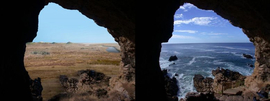Archaeologists Uncover a Lost World and Extinct Ecosystem
By Arizona State University on May 16, 2020
Glacial Period and Today
Looking out at the Palaeo-Agulhas Plain from the cave entrance at the Pinnacle Point, South Africa, research site–left, 200,000 years ago during glacial phases and lower sea levels, and right, today where the ocean is within yards of the cave entrances at high tides. Credit: Erich Fisher
Archaeological sites on the far southern shores of South Africa hold the world’s richest records for the behavioral and cultural origins of our species. At this location, scientists have discovered the earliest evidence for symbolic behavior, complex pyrotechnology, projectile weapons, and the first use of foods from the sea.
Reference: “The Palaeo-Agulhas Plain: A lost world and extinct ecosystem” by Naomi Cleghorn, Alastair J. Potts and Hayley C. Cawthra, 28 April 2020, Quaternary Science Reviews.
DOI: 10.1016/j.quascirev.2020.106308


Enjoy being online again!
Welcome to the community of good people who base their values on evidence and appreciate civil discourse - the social network you will enjoy.Create your free account
Recent Visitors 18
Cast1es
Houston,
t1nick
Western,
Surfpirate
Canada
jasen
Glen Ellyn,
EyesThatSmile
Gulf Coast Of Texas,
Photos 292 More
Posted by JoeBKite-like structures in the western Sahara Desert.
Posted by TriphidAn Aussie Indigenous Message Stick.
Posted by TriphidIndigenous Australian Aboriginal Rock art dated somewhere between 20 and 30 thousand years old.
Posted by TriphidIndigenous Australian Aboriginal Rock art dated somewhere between 20 and 30 thousand years old.
Posted by TriphidIndigenous Australian Aboriginal Rock art dated somewhere between 20 and 30 thousand years old.
Posted by TriphidIndigenous Australian Aboriginal Rock art dated somewhere between 20 and 30 thousand years old.
Posted by JoeBDortoka vremiri: A new species of Dortokid Turtle from the Late Cretaceous of the Hațeg Basin, Romania.
Posted by JoeBThe Cabeço da Amoreira burial: An Early Modern Era West African buried in a Mesolithic shell midden in Portugal.
Posted by JoeBMusivavis amabilis: A new species of Enantiornithine Bird from the Early Cretaceous Jehol Biota of northeastern China.
Posted by JoeBTorosaurus in Canada.
Posted by JoeBStone tools from the Borselan Rock Shelter, in the Binalud Mountains of northeastern Iran.
Posted by JoeBDating the Lantian Biota.
Posted by JoeBBashanosaurus primitivus: A new species of Stegosaur from the Middle Jurassic of Chongqing Municipality, China.
Posted by JoeBDetermining the time of year when the Chicxulub Impactor fell.
Posted by JoeBSão Tomé and Príncipe: Possibly the last country on Earth never to have been visited by a working archaeologist.
Posted by JoeBMambawakale ruhuhu: A new species of Pseudosuchian Archosaur from the Middle Triassic Manda Beds of Tanzania.
Members 658Top
Moderator
Related GroupsMore
Religion of Science & Higher Consciousness
77 members
Political Posts, Articles and Memes
169 members
"I was blocked!?" Group
95 members
Conservative Bashers And Progressive Pushers
136 members
Trump Pinata
1142 members
Out Of The Illusion
1742 members
FreeThinkers
2693 members
Progressives, Socialists, and Black/Palestinian Lives Matter
2460 members






